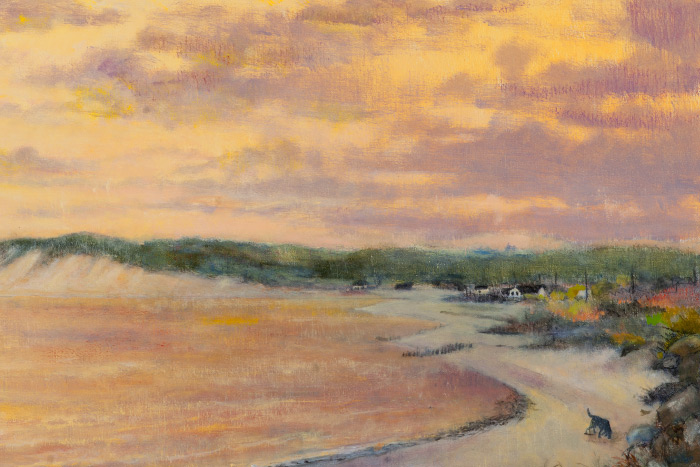A Talk with Dan's Papers Cover Artist Ralph Carpentier

Ralph Carpentier, known to many longtime East End residents and art lovers as “the dean of landscape painting,” has been at it to great acclaim for over 50 years. He paints, he says, because he’s in love with the region, not because he’s interested “in finding some tricky, identifiable Carpentier style.”
The irony is that admirers, including gallery owners and curators, talk of “Carpentier clouds,” as these figure in his quietly elegant compositions that celebrate the fields and farms and waterways of the East End. His works also testify to the strength of representation in an area known for abstract expressionism. Viewers may think they recognize the places that inspire him—he signals as much with titles, such as this week’s “Gerard Point to Barnes Hole”—but he says he’s more faithful to the spirit of a place and to the local people who farm and fish the area than to rendering a location exactly as it is.
Carpentier worked as a commercial fisherman for a time, which likely informed his art. There’s been a slight shift in palette and mood in recent years, however: more mellow scenes, sunset yellows and oranges, looser brushwork. But always what is central is a perfect composition. A truck, a figure, a dog may be the last detail to be added, but his eye tells him what is needed.
Neither calendrical nostalgic nor pointedly supporting advocacy groups, his work has nonetheless attracted environmental groups such as the Accabonac Protection Committee (APC) who see in his paintings enduring qualities of nature in harmony with man. His devotion to the East End should come as no surprise to those who know of his civic contributions over the years. He was at one time at the helm of the East Hampton Town Marine Museum and the East Hampton Historical Society, and he also served on the boards of the Amagansett Historical Association and the East Hampton Town Architectural Review Board, as well as being a Town Trustee.
You’ve had a remarkable career so far that has included teaching. What did you tell your students at the Art Barge, East Hampton High School and Southampton College?
Learn to draw, draw, draw. I do drawings in the field before I paint. Two of my recent shows—Images of Accabonac for APC and a solo room at Ashawagh Hall—contained a few of my pencil drawings. It’s important that artists know classical techniques and study traditions. I’ve always had a lot of books on drawing—figures, portraits, subjects in nature, books considered the best in their field. I’ve spent a lot of time on art history and going to museums. It was at the Frick that I fell in love with [Jean-Baptiste-Camille] Corot.
What painters have been important for you?
I went to the School of Industrial Arts, where I learned how to draw. We were trained to be book illustrators. I wanted to go to the National Academy of Design for drawing but my father urged me to go college and become a teacher, so I went to NYU, which at that time was the cool art place in the city. Barnett Newman, Franz Kline, Willem de Kooning were there. So was William Baziotes, who was into Surrealism and Abstract Expressionism. Most of the students wanted to move in that direction, but classical, traditional work was always my passion. Corot was my early love and Fitz Hugh Lane, the 19th century American seascape painter and printmaker identified with Luminism, a “polished and meticulous realism” where light is paramount, became my idol after that—I named my boat after him! I also admire the 17th century Dutch landscape painters, the Hudson River School, Cubists. And, of course, I love Picasso, fine artists of any time working in any medium, pros who really know traditions and what they’re doing.
How much do you work on a painting?
A lot. I repaint until your eye moves across and into the scene. Sometimes a friend will drop by and notice that a painting I was working on for a while that had a few cows in it, well, the cows were gone. Other times, a landscape will intuitively acquire a dog or a truck or another barn. The horizon line is usually low. Composition is everything.




